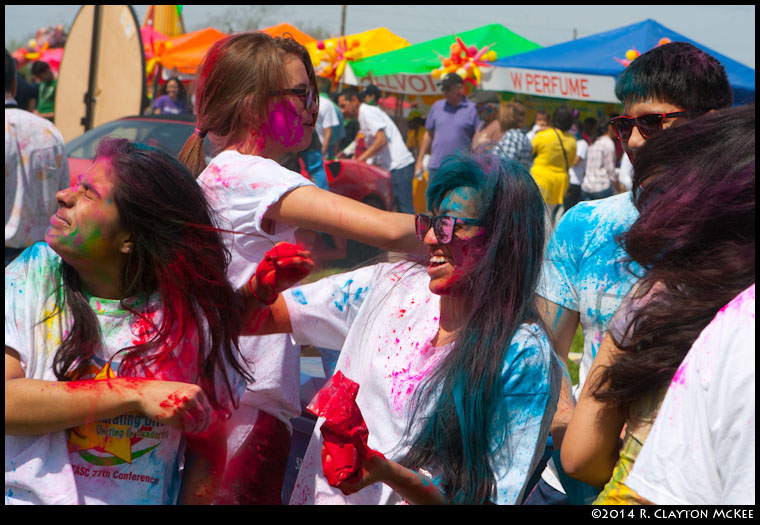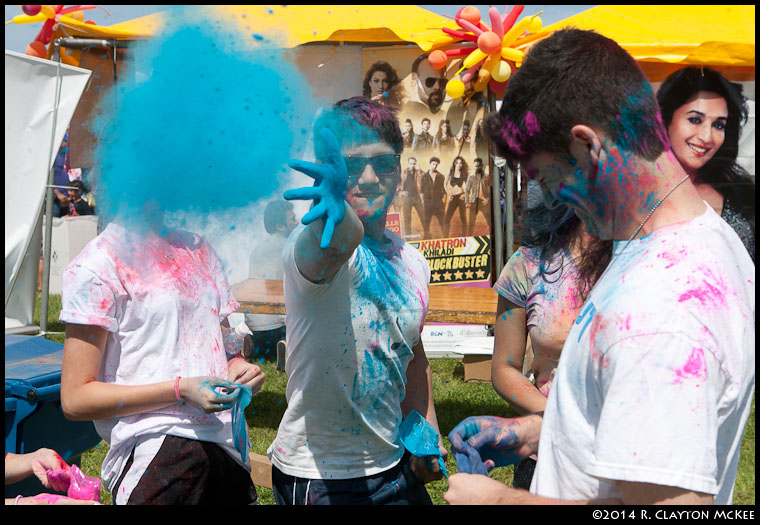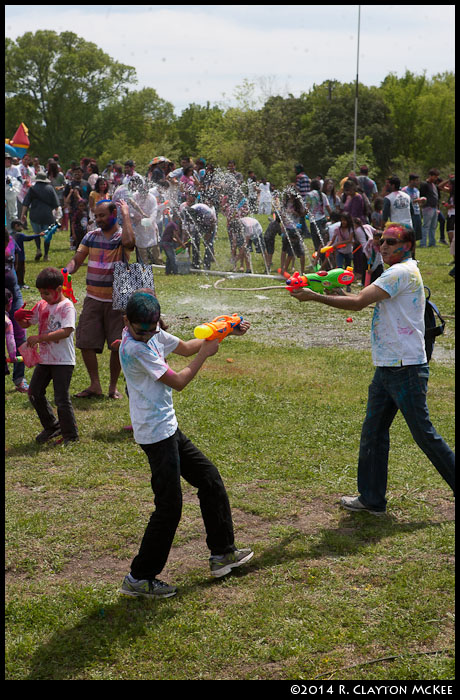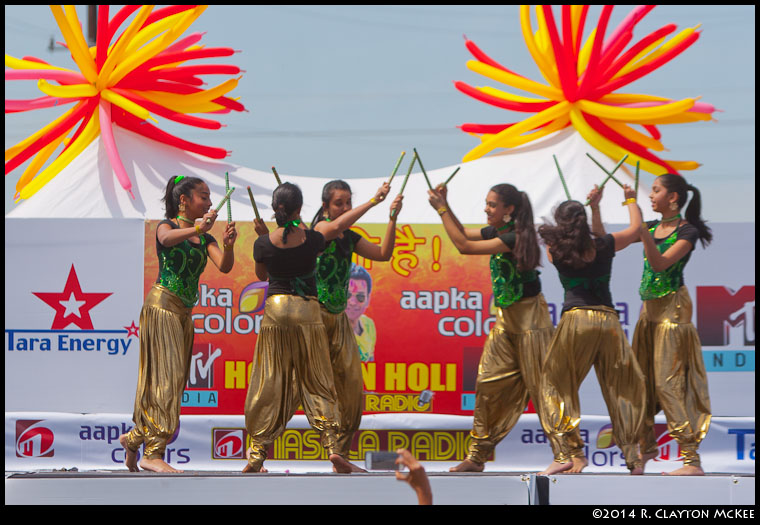Bura na mano, Holi hai. (29.52378 N, 98.80688 W)
I made it about 50 yards before they got me.
I’d stopped by the side of a food booth, which was selling things I couldn’t pronounce, talking with a elderly gent I’d met somewhere before. We were both trying to sort out “where do we know each other from?” when, out of nowhere in particular, a little hand snaked up and smacked me in the face. There was a high-pitched shriek of laughter and a scamper of little feet as my assailant ran away behind me, and when I looked down at my vest, a large stain of crimson had dripped down from my neck. The old man looked at me, shook his head, and said softly, “Happy Holi.”
And then he grinned and got me from the other side with a splash of shocking electric blue.
Thus it was that I became one of the colored people.
——
The Hindu festival of Holi probably started as a spring harvest celebration, with mythological meanings added in somewhen. For the interested (skip this if you’re not, no one will know) the mythology begins with a king, Hiranyakashipu, whose son Prahlada became a devotee of Lord Vishnu. This annoyed His Majesty, who had declared himself a god (he wasn’t) and demanded worship. Prahlada declined, which made Papa H. even MORE annoyed. The king’s son refuses to worship the king. Something Must Be Done About This.
Well, the Evil King had an evil king’s sister, Holika, who had somehow become immune to fire (accounts differ as to exactly how this happened), so the king and his sister contrived to have Holika and Prahlada wind up together in the middle of a big bonfire. Son dies, sister walks, everybody’s happy, right?. Fortunately for our hero, Prahlada, he prayed to Vishnu and by way of some sort of divine intervention, Holika’s immunity transferred itself to Prahlada – and Holika burned up. Before she died, she begged forgiveness from Prahlada and he promised she would be remembered. Thus we have the “Holi” festival, which traditionally begins with a bonfire, and celebrates the triumph of good over evil. ( I read also that at some uncertain point thereafter, Vishnu himself took care of the Evil King with the long name, so that all came out all right in the end, too.)
Holi has other connections with mythology; the use of colors comes from (among other sources), Lord Krishna’s play with his consort, Radhu, and possibly from pranks Lord Krishna was known to have played on the local maidens, throwing colored water on them, chasing them with color, and so forth.
But most of that is perhaps akin to arguing the actual history of Santa Claus… fascinating if that’s your personal twist, but by and large not immediately interesting to celebrants.
(Those who had stopped reading may now rejoin us.)
Holi has become primarily a time to let the hair down and get just a wee bit crazy. Winter’s over, spring has sprung, and it’s time for a happy day or two where most of the rules of proper behavior are put on the shelf and the world gets colorful again.

It’s also known as The Festival Of Colors, celebrated largely by roaming the streets and byways, or parks if they’re handy, throwing or smearing colored powder on friends, family, and complete strangers (also known as “friends you haven’t met yet”),

and even the occasional wandering photographer (though not his cameras, for which I am thoroughly grateful). If you’re of a mind it’s also acceptable to spray just about anyone – except, apparently, the guy with the cameras (thank you!) with colored water, too.

The Mela, or public festival, is a giant party with music and dancing (including Bollywood-style ensemble numbers)

and food and frolic and all manner of shenanigans, where social standing doesn’t matter, mores are relaxed, people you don’t know can casually walk up to you and alter your complexion, everyone has a great deal of fun and there are ridiculous smiles on everyone’s faces. As a result, it’s gone more or less global as a holiday. Where there are Indians, there is Holi. And after all, we can all use some days of sheer joy and brightness. Ideas like that tend to spread easily.
They’ve made it to Texas, anyway. We have a large Indian community here in Houston, large enough that the celebration bills itself as one of the largest Holi Mela in the US and brings thousands of people from all over the state and probably much further. This was the seventh annual celebration, organized (as usual) by Masala Radio, the local Indian / Bollywood station, and several other community groups. I’d been wanting to check it out for every one of those years, because it looked like an unlimited amount of fun, and this time I finally remembered early enough to get there.
——
My new friend, the Man with the Blue Hands, leaned in and quietly warned me to be careful around the kids with the water guns, because they’re kids and when the water starts spraying they may not be looking out for cameras, and added that I should stay off the hill when the water sprayers started. The color won’t hurt the cameras (and I had a brush in my pocket) but if they get wet with the color on them it might be hard to clean them off. I thanked him and we traded grins again, then he went back to cooking and I went in search of pictures and the little one with the quick hands.
And I found them. Or they found me.
About a thousand, give or take, which I’ve edited down to a handful of color.
http://theothertexas.net/gallery/2014-houston-holi-festival/
Bura na mano, Holi hai.
(Something else I learned from my new friends. “Don’t worry about it, it’s Holi!”)
—————-
Further detailed reading:
1. I Love India (Holi page: http://festivals.iloveindia.com/holi/index.html)
2. India Express (Holi page: http://www.indiaexpress.com/rangoli/holi.html)
3. Religion Facts (http://www.religionfacts.com/hinduism/holidays/holi.htm)
4. Wikipedia (http://en.wikipedia.org/wiki/Holi)
